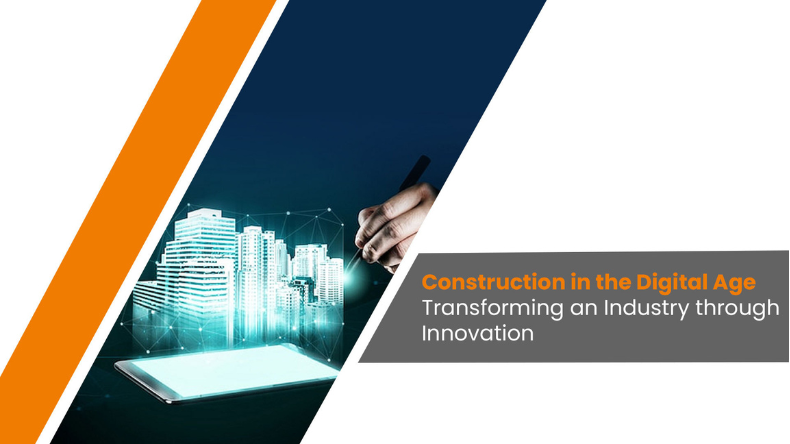Reading Time: 6 minutes
Abstract
The construction industry has historically been slow to adopt digital technologies compared to other sectors. However, with recent advancements in software, hardware, and data analytics, the digital age is reshaping the way construction projects are designed, executed, and managed. This whitepaper explores the critical technologies driving the transformation of the construction sector, examining the benefits, challenges, and future outlook of construction in the digital age.
Introduction
The construction industry is a critical component of the global economy, accounting for approximately 13% of global GDP. However, it has long been plagued by inefficiencies, with projects often running over budget and behind schedule. In response, digital transformation has emerged as a promising solution, with advanced technologies paving the way for greater productivity, efficiency, and precision in construction projects. This whitepaper examines how digital technologies are revolutionizing construction, addressing challenges, and shaping the industry’s future.
The Current State of the Construction Industry
Despite its economic significance, the construction industry has traditionally been slow to innovate. Factors such as low-profit margins, reliance on manual labor, and complex stakeholder dynamics have contributed to a resistance to change. Additionally, construction is inherently a high-risk industry, with safety and project management challenges that are often exacerbated by fragmented communication across teams.
Work Smarter, Not Harder
iFieldSmart empowers your team with AI-driven efficiency to simplify scheduling, boost collaboration, and keep projects on track.
Schedule a MeetingThe COVID-19 pandemic accelerated the need for digital solutions, as remote work and social distancing measures became a necessity. Digital transformation in construction, therefore, is no longer an option but an imperative for companies seeking to stay competitive and resilient.
Key Technologies Driving Digital Transformation
Building Information Modeling (BIM)
Building Information Modeling (BIM) is a process that enables the creation of digital representations of physical and functional characteristics of buildings. BIM facilitates collaboration across disciplines and provides a single source of truth throughout a project’s lifecycle. BIM models allow for 3D visualization, clash detection, and simulation, enhancing efficiency in project design and execution.
Artificial Intelligence (AI) and Machine Learning
AI and machine learning are being applied in construction for predictive analytics, risk management, and optimization. Machine learning algorithms analyze historical data to forecast potential issues and delays, while AI-driven robotics are used to automate repetitive tasks such as bricklaying and inspection.
Internet of Things (IoT) and Smart Sensors
IoT technology allows for the integration of smart sensors on construction sites to collect real-time data on equipment, materials, and environmental conditions. This data is used for monitoring safety, managing inventory, and ensuring optimal resource utilization. Connected equipment and wearables provide valuable insights into site operations, which can help improve safety and productivity.
Augmented Reality (AR) and Virtual Reality (VR)
AR and VR are transforming the way construction projects are visualized and managed. AR enables workers to overlay digital models onto real-world structures for on-site verification and quality control. VR, on the other hand, allows stakeholders to experience 3D models of projects, making it easier to identify design flaws and make adjustments before construction begins.
Drones and Robotics
Drones are widely used for site surveying, monitoring, and inspection. They capture high-resolution aerial images that can be used to create 3D models of a site, monitor progress, and assess structural integrity. Robotics, such as autonomous excavators and brick-laying robots, are also enhancing productivity by automating labor-intensive tasks and reducing human error.
Cloud Computing and Digital Twins
Cloud computing allows construction teams to access project information and collaborate from anywhere, ensuring continuity and reducing rework. Digital twins, which are virtual replicas of physical assets, enable real-time monitoring and predictive maintenance. They provide a holistic view of the asset’s lifecycle, from design through to operation and maintenance.
Benefits of Digital Transformation in Construction
Enhanced Efficiency and Productivity
Digital tools streamline workflows, reduce the time spent on manual tasks, and improve project coordination. Technologies like BIM and IoT-based systems reduce rework by enabling more accurate planning and real-time adjustments.
Improved Safety and Risk Management
The use of AI-powered safety analytics, wearable’s, and real-time monitoring minimizes on-site risks. Drones and robots take over hazardous tasks, while predictive analytics identify potential safety issues before they escalate, creating a safer work environment.
Better Cost Management and Budget Adherence
Digital transformation reduces inefficiencies and waste, allowing for better cost management. Predictive analytics help project managers anticipate cost overruns, while automated processes minimize labor costs and improve material usage, contributing to projects staying within budget.
Enhanced Collaboration and Communication
Cloud platforms and BIM facilitate collaboration among project stakeholders, including architects, engineers, and contractors. Digital documentation and real-time data sharing ensure everyone is on the same page, reducing miscommunication and improving decision-making.
Challenges of Digital Transformation in Construction
High Initial Costs
The adoption of digital technologies requires significant upfront investment in software, hardware, and training. For smaller companies, the cost barrier can be prohibitive, particularly if the long-term return on investment is not immediately clear.
Skill Gaps and Workforce Training
Digital transformation requires a workforce skilled in digital tools and data analytics. The construction industry faces a skill gap, as many workers lack the expertise needed to use advanced technologies, necessitating investment in training and development.
Data Security and Privacy Concerns
The digitization of construction data presents cyber security challenges. IoT devices and cloud-based systems are vulnerable to cyber attacks, which can compromise sensitive information and disrupt operations. Ensuring robust cyber security protocols is essential to mitigate these risks.
Resistance to Change and Cultural Barriers
Resistance to digital transformation is common in the construction industry, where traditional methods have long been the norm. Changing organizational culture and convincing stakeholders of the benefits of digital technologies is an ongoing challenge.
Case Studies: Successful Implementation of Digital Technologies
Case Study 1: A leading construction company implemented BIM for a large-scale infrastructure project, resulting in a 20% reduction in design time and a 15% decrease in material waste.
Case Study 2: A construction firm adopted drones and IoT sensors on-site, which provided real-time data on project progress and reduced site inspection times by 40%.
Case Study 3: A commercial builder utilized VR for client engagement, allowing clients to virtually tour projects and make design changes, reducing rework by 30%.
The Future of Construction in the Digital Age
The future of construction lies in further integration of digital technologies such as AI, robotics, and digital twins. We can expect increased adoption of autonomous machinery, advanced data analytics, and AI-driven decision-making. Digital transformation will also be driven by regulatory pressures for greener, safer, and more efficient buildings, with sustainability emerging as a focal point. Furthermore, as technologies become more affordable, even small and medium-sized companies will join the digital transformation journey.
The construction industry’s digital transformation will not only improve efficiency and productivity but also create new business models, where data-driven insights drive strategic decision-making and enable the delivery of more innovative, customized, and sustainable projects.
Conclusion
Construction in the digital age represents a paradigm shift from traditional, labor-intensive practices to a technology-driven approach. This transformation, while challenging, offers substantial benefits, including increased efficiency, safety, and cost-effectiveness. As the industry continues to adopt and integrate new technologies, construction companies that embrace digital innovation will be well-positioned to lead in a highly competitive market.








